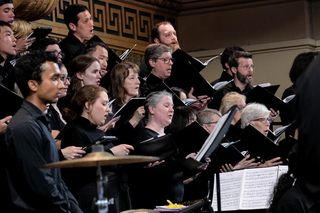Since the very first journeys to Santiago de Compostela began over 1,000 years ago, the Way of St. James has been articulated and celebrated in music. The vast Codex Calixtinus, dating from the twelfth century, is a compendium of advice and instructions for pilgrims, sermons, reports of miracles, prayers, and polyphonic motets. Over the years many concert programs have been devised to relive the medieval pilgrims’ journey in song, drawn from the codex and other sources, and new pieces have been composed which also reimagine the experience of travelling the Way of St. James.
So the challenge with this piece was to try to say something new and worthwhile about the pilgrimage to Santiago de Compostela that hadn’t already been said. I didn’t want to write a literal account of the journey, a series of postcards from the pilgrimage route—today we are in Puente la Reina… tomorrow we reach Finisterre—for that has already been done and done very well. So while To the Field of Stars is about the pilgrimage to Santiago, it is also about journeying in a wider sense—the physical, emotional and psychological struggle to reach a long-sought after and life-changing goal.
One of the first things that struck me was the possible etymological origin of “Compostela” as “campus stellae”—the field of stars. This suggested a literal field of stars, and that notion became the sixth movement of the piece, a sustained, glistening carpet of murmured stars’ names underpinning a flickering high cello descant.
In order to articulate and give structure to the journey, the piece is divided into seven movements, seven “stations” as it were, points of meditation and reflection which are separated by choral refrains and brief cello envoix. The texts of the refrains are drawn from a medieval pilgrims’ hymn in the Codex Calixtinus and they also act as a Latin grammar primer, each verse addressing St. James in one of the six grammatical cases (nominative, genitive, vocative, etc.). These bare and rustic-sounding refrains are isorhythmic—the rhythm remains identical each time, only the pitches changing.
The piece begins with an ecstatic and ululatory Intrada, a brief choral fanfare that apostrophizes St. James and his illustrious martyrdom. The seven movements that follow are both stages in the physical journey and reflections on the transforming experience of any arduous voyage, often sparked by key words in the preceding refrain in a kind of free association.
“Prayer for Travelling” is by turns optimistic and apprehensive, full of both fear and excitement about the journey ahead. A quiet chorale is repeatedly answered by melismatic exclamations from upper voices and cello replete with sighing appoggiaturas and declamatory glissandi.
In the second movement, “Pilgrims’ Song with History Lesson,” the female voices sing of the joys of travel in rather obsessively jubilant tones. At this stage of the journey there is much to look forward to, and the almost-nonsense verse of their effusions is anchored by a jaunty march from the cello. Later in the movement we hear an account of the history of the shrine from the second president of the USA, John Adams.
“Walking with God” is dominated, in contrast, by the male voices, a dark-hued riposte to the bright cheerfulness of the preceding movement. Cowper’s poem, so familiar as a comfortable Anglican hymn, is here reimagined as a raw and angry dark night of the soul. Beset by doubt and uncertainty, the pilgrims sing in ornate and anguished tones, thoughts of the dove of peace offering a brief moment of balm, and leading to a quiet and unsure conclusion.
St. James was noted for his performance of miracles, and in the fourth movement Walt Whitman tells of his apprehension of the divine in the everyday in a poem that is truly sacred in the broadest sense. Linguistically rich and full of ritualistic repetition, Whitman’s vision is set to some of the lushest music in the piece, its polyphonic intertwinings both meditative and sensual.
In Emily Dickinson’s “Our Journey Had Advanced” the end destination is almost certainly death (as was her wont) but that “God at every gate” may equally be found at the shrine of St. James. The movement is simple and quiet, for the most part, its bare homophony briefly overlaid with filigree in the second verse.
In a kind of other-wordly interlude, the whispered field of stars that is the sixth movement supports a solo soprano cantilena that also longs for those “heavenly citadels among the stars.”
And then, at last, we reach our destination— the Basilica of St. James—and “O how glorious is the kingdom” indeed!
2011, the year in which the piece was written, was the 400th anniversary of the death of the great Spanish composer Tomás Luis de Victoria and here his iconic four-part motet is elaborated by a further four polyphonic voices, its long concluding pedal- point launching the final peroration, an exuberant and jubilant hymn to St. James. Bedecked by virtuosic cello roulades and chiming bell sounds, the piece ends, exhausted but uplifted, in a clanging pæan of fortissimo ecstasy.
Gabriel Jackson (2015)
